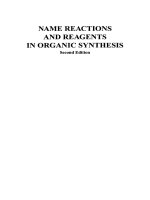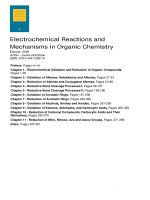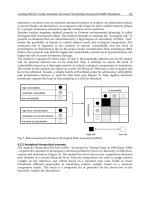Amino acids, peptides and proteins in organic chemistry volume 4 protection reactions, medicinal chemistry, combinatorial synthesis (amino acids, peptides and proteins in organic chemistry (VCH)) andrew b h
Bạn đang xem bản rút gọn của tài liệu. Xem và tải ngay bản đầy đủ của tài liệu tại đây (5.55 MB, 538 trang )
Edited by
Andrew B. Hughes
Amino Acids, Peptides
and Proteins in
Organic Chemistry
Further Reading
Pignataro, B. (ed.)
Drauz, K., Gröger, H., May, O. (eds.)
Ideas in Chemistry and
Molecular Sciences
Enzyme Catalysis in Organic
Synthesis
Advances in Synthetic Chemistry
Third, completely revised
and enlarged edition
2010
ISBN: 978-3-527-32539-9
3 Volumes
2011
Theophil Eicher, Siegfried Hauptmann
and Andreas Speicher
ISBN: 978-3-527-32547-4
The Chemistry of Heterocycles
Fessner, W.-D., Anthonsen, T.
Structure, Reactions, Synthesis, and
Applications
Modern Biocatalysis
2011
Stereoselective and Environmentally
Friendly Reactions
ISBN: 978-3-527-32868-0 (Hardcover)
ISBN: 978-3-527-32747-8 (Softcover)
2009
Royer, J. (ed.)
Lutz, S., Bornscheuer, U. T. (eds.)
Asymmetric Synthesis of
Nitrogen Heterocycles
Protein Engineering Handbook
2009
2009
ISBN: 978-3-527-32036-3
ISBN: 978-3-527-31850-6
Reek, J. N. H., Otto, S.
Sewald, N., Jakubke, H.-D.
Dynamic Combinatorial
Chemistry
Peptides: Chemistry and
Biology
2010
2009
ISBN: 978-3-527-32122-3
ISBN: 978-3-527-31867-4
Rutjes, F., Fokin, V. V. (eds.)
Jakubke, H.-D., Sewald, N.
Click Chemistry
Peptides from A to Z
in Chemistry, Biology and
Macromolecular Science
A Concise Encyclopedia
2011
ISBN: 978-3-527-31722-6
ISBN: 978-3-527-32071-4
2 Volume Set
2008
ISBN: 978-3-527-32085-1
Nicolaou, K. C., Chen, J. S.
Classics in Total Synthesis III
New Targets, Strategies, Methods
2011
ISBN: 978-3-527-32958-8 (Hardcover)
ISBN: 978-3-527-32957-1 (Softcover)
Edited by
Andrew B. Hughes
Amino Acids, Peptides and Proteins
in Organic Chemistry
Volume 4 - Protection Reactions, Medicinal Chemistry,
Combinatorial Synthesis
The Editor
Andrew B. Hughes
La Trobe University
Department of Chemistry
Victoria 3086
Australia
All books published by Wiley-VCH are carefully
produced. Nevertheless, authors, editors, and
publisher do not warrant the information contained
in these books, including this book, to be free of
errors. Readers are advised to keep in mind that
statements, data, illustrations, procedural details or
other items may inadvertently be inaccurate.
Library of Congress Card No.: applied for
British Library Cataloguing-in-Publication Data
A catalogue record for this book is available from the
British Library.
Bibliographic information published by
the Deutsche Nationalbibliothek
The Deutsche Nationalbibliothek lists this
publication in the Deutsche Nationalbibliografie;
detailed bibliographic data are available on the
Internet at .
# 2011 WILEY-VCH Verlag & Co. KGaA,
Boschstr. 12, 69469 Weinheim, Germany
All rights reserved (including those of translation into
other languages). No part of this book may be
reproduced in any form – by photoprinting,
microfilm, or any other means – nor transmitted or
translated into a machine language without written
permission from the publishers. Registered names,
trademarks, etc. used in this book, even when not
specifically marked as such, are not to be considered
unprotected by law.
Composition Thomson Digital, Noida, India
Printing and Bookbinding Strauss GmbH,
Mörlenbach
Cover Design Schulz Grafik Design, Fußgönheim
Printed in the Federal Republic of Germany
Printed on acid-free paper
ISBN: 978-3-527-32103-2
V
Contents
List of Contributors
1
1.1
1.2
1.2.1
1.2.1.1
1.2.1.1.1
1.2.1.1.2
1.2.1.1.3
1.2.1.2
1.2.1.3
1.2.1.4
1.2.1.4.1
1.2.1.4.2
1.2.1.4.3
1.2.1.4.4
1.2.1.5
1.2.2
1.2.2.1
1.2.2.2
1.2.2.2.1
1.2.2.2.2
1.2.2.2.3
1.2.2.2.4
1.2.2.3
1.2.2.4
1.2.2.4.1
1.2.2.4.2
1.2.2.5
XVII
Protection Reactions 1
Vommina V. Sureshbabu and Narasimhamurthy Narendra
General Considerations 1
a-Amino Protection (Na Protection) 4
Non-Urethanes 4
Acyl Type 4
Monoacyl Groups 5
Groups Cleavable via Lactam Formation 6
Diacyl Groups 7
Phosphine-Type Groups 10
Sulfonyl-Type Groups 10
Alkyl-Type Groups 11
Triphenylmethyl (Trityl or Trt) Group 11
Benzhydryl Groups 12
N,N-Bis-Benzyl Protection 12
Vinyl Groups 12
Sulfanyl-Type Groups 13
Urethanes (Carbamates or Alkyloxycarbonyl Groups) 14
Formation of the Urethane Bond 16
Urethanes Derived from Primary Alcohols 16
Benzyloxycarbonyl (Cbz or Z) Group 16
Urethanes Cleaved by b-Elimination 19
Urethanes Cleaved via Michael-Type Addition 24
Allyloxycarbonyl (Aloc) Group 25
Urethane Groups Derived from Secondary Alcohols 25
Urethanes Derived from Tertiary Alcohols 25
tert-Butoxycarbonyl (Boc) Group 25
Boc Analogs 28
Other Aspects of Urethane Protectors 29
Amino Acids, Peptides and Proteins in Organic Chemistry.
Vol.4 – Protection Reactions, Medicinal Chemistry, Combinatorial Synthesis. Edited by Andrew B. Hughes
Copyright Ó 2011 WILEY-VCH Verlag GmbH & Co. KGaA, Weinheim
ISBN: 978-3-527-32103-2
VI
Contents
1.2.2.5.1
1.2.2.5.2
1.2.2.5.3
1.2.2.5.4
1.2.3
1.2.3.1
1.2.3.2
1.2.3.3
1.3
1.3.1
1.3.1.1
1.3.2
1.3.2.1
1.3.3
1.3.4
1.3.5
1.3.6
1.3.7
1.4
1.4.1
1.4.2
1.4.2.1
1.4.2.2
1.4.2.3
1.4.3
1.4.4
1.4.5
1.4.6
1.4.6.1
1.4.6.1.1
1.4.6.1.2
1.4.6.1.3
1.4.6.2
1.4.7
1.4.8
1.4.9
1.4.9.1
1.5
1.6
1.7
1.7.1
1.7.1.1
Formation of Dipeptide Impurities during the Introduction
of Urethanes and Protocols to Overcome It 29
Introduction of Urethanes via Transprotection 30
Protection of the Nitrogen of a-Amino Acid
N-Carboxy Anhydrides (NCAs) 31
Na,Na-bis-Protected Amino Acids 32
Other Na-Protecting Groups 32
a-Azido Acids as a-Amino Acid Precursors 33
One-Pot Na Protection and Ca Activation 33
Effect of Na-Protecting Groups in the Synthesis of NMAs 33
Carboxy Protection 34
Methyl and Ethyl Esters 35
Substituted Methyl and Ethyl Esters 36
Benzyl Ester 36
Cleavage 36
Substituted Benzyl Esters 38
tert-Butyl Ester 38
Other Acid-Labile Esters 39
Temporary a-Carboxy Protection 39
a-Carboxy Protectors as Precursors to Useful Amino
Acid Derivatives: Formation of Acid Hydrazides 41
Side-Chain Protection 41
o-Amino Group of Diamino Acids 41
Guanidino Group of Arg 43
Protection Through Protonation 43
Nitration 44
Arg Precursors 45
Imidazole Group of His 45
Indole Group of Trp 48
o-Amido Group of Asn and Gln 49
b-Thiol Group of Cys 50
Common Side-Reactions with S-Protected Cys Derivatives 51
Racemization 51
b-Elimination 51
Oxidation 51
Synthesis of Peptides Using Cystine as ‘‘Self-Protected’’ Cys 51
Thioether Group of Met 53
Hydroxy Group of Ser, Thr, and the Phenolic Group of Tyr 54
o-Carboxy Group of Asp and Glu 55
Aspartimide Formation 55
Photocleavable Protections 57
Conclusions 58
Experimental Procedures 59
Protection Reactions 59
General Procedure for the Preparation of Tfa-Arg-OH 59
Contents
1.7.1.2
1.7.1.3
1.7.1.4
1.7.1.5
1.7.1.5.1
1.7.1.5.2
1.7.1.6
1.7.1.6.1
1.7.1.6.2
1.7.1.6.3
1.7.1.6.4
1.7.1.7
1.7.1.8
1.7.1.9
1.7.1.10
1.7.1.10.1
1.7.1.10.2
1.7.1.10.3
1.7.1.11
1.7.1.12
1.7.1.13
1.7.1.13.1
1.7.1.13.2
1.7.1.13.3
1.7.1.13.4
1.7.1.14
1.7.1.15
1.7.1.15.1
1.7.1.16
1.7.1.16.1
1.7.1.17
General Procedure for the Preparation of Na-Phthaloyl Amino
Acids using N-(Ethoxycarbonyl)phthalimide 59
General Procedure for the Preparation of Na-Trt-Amino Acids 59
General Procedure for the Preparation of Na-Ns-Amino Acids 60
General Procedure for the Preparation of Na-Z-Amino Acids 61
Method A: Using Z-Cl 61
Method B: Using Z-OSu 62
General Procedures for the Preparation of Na-Fmoc-Amino Acids 62
Method A: Using Fmoc-OSu 62
Method B: Using Fmoc-Cl and N,O-bis-TMS-Amino Acids 62
Method C: Using Fmoc-Cl in the Presence of Zinc Dust 63
Method D: Using Fmoc-N3 63
General Procedure for the Preparation of Na-Nsc-Amino Acids 64
General Procedure for the Preparation of
Na-Bsmoc-Amino Acids 64
General Procedure for the Preparation of
Na-Aloc-Amino Acids 65
General Procedures for the Preparation
of Na-Boc-Amino Acids 65
Method A: Using (Boc)2O 65
Method B: Using Boc-ON 65
Method C: Using Boc-N3 66
General Procedure for the Preparation
of N,N0 -di-Boc-Amino Acids 66
General Procedure for the Preparation of
Na-Bpoc-Amino Acids 67
General Procedures for the Preparation of Amino
Acid Methyl Esters 68
Preparation of Amino Acid Methyl Ester Hydrochloride Salts 68
Isolation of Amino Acid Methyl Esters: Deprotonation
of the Hydrochloride Salt Using Zinc Dust 69
Glutamic Acid a-Methyl, c-tert-Butyl Diester
Using Diazomethane 69
Z-Glu-OMe via Methanolysis of Cyclic Anhydride 69
General Procedure for the Preparation of Amino
Acid Ethyl Esters 69
General Procedure for the Preparation of Amino
Acid Benzyl Ester p-Toluenesulfonate Salts 70
Preparation of Amino Acid Benzyl Ester p-Toluenesulfonate Salts
Under Microwave Irradiation 70
General Procedure for the Preparation of tert-Butyl Esters
of Na-Unprotected Amino Acids Using Isobutene 71
Preparation of Z-Phe-OtBu by the Silver Salt Method 71
General Procedure for Concomitant Protection and Activation
of Amino Acids Using Pentafluorophenyl Carbonate 80
VII
VIII
Contents
1.7.2
1.7.2.1
1.7.2.2
1.7.2.3
1.7.2.3.1
1.7.2.3.2
1.7.2.3.3
1.7.2.4
1.7.2.4.1
1.7.2.4.2
1.7.2.5
1.7.2.5.1
1.7.2.5.2
1.7.2.6
1.7.2.7
1.7.2.8
1.7.2.9
1.7.2.10
1.7.2.11
1.7.2.12
1.7.2.13
Deprotection Reactions 81
Removal of the Phth Group by Hydrazinolysis 81
Removal of the Nps Group 81
Removal the Z-group 82
Protocol A: Employing CH 82
Protocol B: Employing Silylhydride 82
Protocol C: Through CTH using 1,4-Cyclohexadieneas
Hydrogen Donor 83
Cleavage of the Fmoc Group 83
Method A: Using TAEA [67] 83
Method B: Using DEA: Simultaneous Removal of the Fmoc Group
and 9-Fluorenylmethyl Ester 83
Cleavage of the Boc Group 84
Protocol A: Removal of the Boc group with TFA
in the Presence of Scavengers 84
Protocol B: Cleavage of Boc Group with
TMS/Phenol 84
Transprotection of Na-Protecting Groups:
Fmoc-Met-OH to Boc-Met-OH 84
Selective Methyl Ester Hydrolysis in the Presence
of the Na-Fmoc Group 84
Cleavage of tert-Butyl Ester Using BF3ÁEt2O 84
Selective Cleavage of Phenacyl Ester in the
Presence of the Na-Nosyl Group 85
Removal of the Trt Group (Iodolysis) 85
Deprotection of the Pbf Group from Z-Arg(Pbf)-OH 85
Removal of the Phenoc Group through Photolysis 85
Conversion of the DCHA Salt of Na-Protected Amino Acids
into Free Acids 85
References 86
Part One Amino Acid-Based Peptidomimetics
2
2.1
2.2
2.3
2.4
2.5
2.6
2.7
99
Huisgen Cycloaddition in Peptidomimetic Chemistry 101
Daniel Sejer Pedersen and Andrew David Abell
Introduction 101
Huisgen [2 þ 3] Cycloaddition Between Azides and
Acetylenes 102
Mechanistic Consideration for the Cu-Huisgen
and Ru-Huisgen Cycloadditions 103
Building Blocks for the Synthesis of Triazole-Modified
Peptidomimetics 106
Cyclic Triazole Peptidomimetics 109
Acyclic Triazole Peptidomimetics 113
Useful Experimental Procedures 121
Contents
2.7.1
2.7.2
2.7.3
3
3.1
3.1.1
3.1.2
3.1.3
3.1.4
3.2
3.3
3.4
3.5
3.6
3.7
3.8
3.9
3.10
3.11
Monitoring Huisgen Cycloadditions and Characterizing
Triazoles 121
General Procedure for the Synthesis of 1,4-Triazoles
Using Cu-Huisgen Cycloaddition 122
General Procedure for the Synthesis of 1,5-Triazoles
Using Ru-Huisgen Cycloaddition 123
References 124
Recent Advances in b-Strand Mimetics 129
Wendy A. Loughlin and David P. Fairlie
Introduction 129
b-Strands 129
b-Sheets 130
Differences in Strand/Sheet/Turn/Helix Recognition 130
Towards b-Strand Mimetics 131
Macrocyclic Peptidomimetics 133
Acyclic Compounds 135
Aliphatic and Aromatic Carbocycles 136
Ligands Containing One Ring with One Heteroatom (N) 137
Ligands Containing One or Multiple Rings with
One Heteroatom (O, S) 138
Ligands Containing One Ring with Two Heteroatoms (N,N) 139
Ligands Containing One Ring with Two Heteroatoms (N,S)
or Three Heteroatoms (N,N,S or N,N,N) 140
Ligands Containing Two Rings with One Heteroatom (N or O) 140
Ligands Containing Two Rings with Two or Three
Heteroatoms (N,N or N,S or N,N,N) 141
Conclusions 142
References 143
Part Two Medicinal Chemistry of Amino Acids 149
4
4.1
4.2
4.3
4.3.1
4.3.2
4.3.3
4.3.4
4.4
4.4.1
4.4.2
4.5
Medicinal Chemistry of a-Amino Acids 151
Lennart Bunch and Povl Krogsgaard-Larsen
Introduction 151
Glutamic Acid 151
Conformational Restriction 153
Synthesis – General Considerations 154
Case Study: Synthesis of DCAN 155
Case Study: Synthesis of LY354740 157
Case Study: Synthesis of ABHD-V and ABHD-VI 158
Bioisosterism 159
Case Study: Design and Synthesis of AMPA 160
Case Study: Design and Synthesis of Thioibotenic Acid
Structure–Activity Studies 162
161
IX
X
Contents
4.5.1
4.5.2
4.6
Case Study: AMPA Analogs 162
Case Study: 4-Substituted Glu analogs
Conclusions 168
References 169
5
Medicinal Chemistry of Alicyclic b-Amino Acids 175
Nils Griebenow
Introduction 175
Five-Membered Alicyclic b-Amino Acids 175
Six-Membered Alicyclic b-Amino Acids 183
References 186
5.1
5.2
5.3
6
6.1
6.2
6.2.1
6.2.2
6.2.2.1
6.2.2.2
6.2.2.3
6.2.2.4
6.2.2.5
6.2.2.6
6.3
6.4
6.5
6.5.1
6.5.2
6.5.3
6.5.4
6.5.5
6.6
7
7.1
7.2
7.2.1
7.2.2
7.2.3
7.2.4
7.2.5
7.2.5.1
163
Medicinal Chemistry of a-Hydroxy-b-Amino Acids 189
Zyta Ziora, Mariusz Skwarczynski, and Yoshiaki Kiso
Introduction 189
a-Hydroxy-b-Amino Acids 189
a-Hydroxy-b-Amino Acids Occurring in Natural Products
Synthesis of a-Hydroxy-b-Amino Acids 191
Isoserine 191
Isothreonine 193
Phenylisoserine 197
Norstatines 197
3-Amino-2-Hydroxydecanoic Acid and its Analogs 204
Synthetic Demands 205
Antibacterial Agents 205
Inhibitors of Aminopeptidases 207
Aspartyl Proteases Inhibitors 211
Renin Inhibitors 212
HIV-1 Protease Inhibitors 216
HTLV-I Inhibitors 220
Plasmepsin II Inhibitors 222
BACE-1 Inhibitors 224
Paclitaxel and its Derivatives 228
References 234
Peptide Drugs 247
Chiara Falciani, Alessandro Pini, and Luisa Bracci
Lights and Shades of Peptide and Protein Drugs
Peptide Drugs Available on the Market 249
Natriuretic Peptide (Nesiritide) 249
Oxytocin 249
Vasopressin 250
Desmopressin 251
Blood Coagulation Inhibitors 251
Bivalirudin 251
247
189
Contents
7.2.5.2
7.2.6
7.2.6.1
7.2.6.2
7.2.6.3
7.2.6.4
7.2.7
7.2.7.1
7.2.7.2
7.2.7.3
7.2.8
7.2.9
7.2.10
7.2.11
7.2.12
7.2.13
7.3
7.3.1
7.3.2
7.3.3
7.3.4
7.3.5
7.3.6
7.4
7.4.1
7.4.2
7.4.3
7.5
7.5.1
7.5.2
8
8.1
8.2
8.3
8.4
8.4.1
8.4.1.1
8.4.1.2
Integrilin (Eptifibatide) 251
Gonadotropin-Releasing Hormone Agonists and
Antagonists 251
Gonadorelin 251
Lupron(Leuprolide) 252
Cetrorelix 253
Degarelix 253
Antihyperglycemics 254
Symlin (Pramlintide) 254
Exendin-4 254
Liraglutide 255
Icatibant 255
Sermorelin 256
Calcitonin 256
Parathyroid Hormone 256
Cyclosporine 257
Fuzeon 257
Approved Peptides in Oncology 258
Bortezomib 259
Actinomycin D 259
Marimastat 260
Octreotide 260
Vapreotide 261
Octreoscan 262
Antimicrobial peptides 263
Polymyxin 265
Daptomycin 266
Gramicidin S 267
Perspectives 267
Branched Peptides as Tumor-Targeting Agents 268
Branched Peptides as Antimicrobials 270
References 271
Oral Bioavailability of Peptide and Peptidomimetic Drugs 277
Arik Dahan, Yasuhiro Tsume, Jing Sun, Jonathan M. Miller,
and Gordon L. Amidon
Introduction 277
Fundamental Considerations of Intestinal Absorption 277
Barriers Limiting Oral Peptide/Peptidomimetic
Drug Bioavailability 279
Strategies to Improve Oral Bioavailability of Peptide-Based
Drugs 280
Chemical Modifications 280
Prodrug Approach 280
Structural Modifications 281
XI
XII
Contents
8.4.2
8.4.2.1
8.4.2.2
8.4.2.3
8.4.2.4
8.5
Formulation Technologies 284
Absorption Enhancers 284
Coadministration with Protease Inhibitors
Formulation Vehicles 285
Site-Specific Delivery 286
Conclusions 287
References 287
9
Asymmetric Synthesis of b-Lactams via the Staudinger Reaction 293
Monika I. Konaklieva and Balbina J. Plotkin
Introduction 293
Staudinger Reaction 293
Influence of the Geometry of the Imine on Stereoselectivity
in the Reaction 294
Influence of the Polarity of the Solvent on Stereoselectivity
of the Reaction 296
Influence of the Isomerization of the Imine Prior
to its Nucleophilic Attack onto the Ketene Stereoselectivity
in the Reaction 296
Influence of the Order of Addition of the Reactants
to the Reaction 297
Influence of Chiral Substituents on the Stereoselectivity
of the Reaction 298
Asymmetric Induction from the Imine Component 298
Asymmetric Induction from the Ketene Component 305
Double Asymmetric Cycloinduction 308
Influence of Catalysts on the Stereoselectivity
of the Reaction 309
General Procedure for b-Lactams 106 with Proton Sponge 312
General Procedure for the Tandem Nucleophile/Lewis
Acid-Promoted Synthesis of b-Lactams 110 312
General Procedure for Catalytic Asymmetric
Synthesis of Trans-b-Lactams 113 314
Example for Kinugasa Reaction with Cu (II) Catalyst 316
General Procedure for Catalytic Asymmetric Synthesis
of b-Lactams 122 316
Conclusions 316
References 317
9.1
9.2
9.3
9.4
9.5
9.6
9.7
9.8
9.9
9.10
9.11
9.11.1
9.11.2
9.11.3
9.11.4
9.11.4.1
9.12
10
10.1
10.2
10.2.1
285
Advances in N- and O-Glycopeptide Synthesis – A Tool to
Study Glycosylation and Develop New Therapeutics 321
Ulrika Westerlind and Horst Kunz
Introduction 321
Synthesis of O-Glycopeptides 324
Synthesis of Mucin-Type Glycopeptides 325
Contents
10.2.1.1
10.2.1.1.1
10.2.1.1.2
10.2.1.2
10.2.1.2.1
10.2.1.2.2
10.2.1.2.3
10.2.2
10.2.2.1
10.2.2.2
10.3
10.3.1
10.3.2
10.3.2.1
10.3.2.2
10.3.3
10.3.3.1
10.3.3.2
10.3.3.3
11
11.1
11.2
11.2.1
11.2.2
11.2.3
11.2.4
11.2.5
11.3
11.3.1
11.3.2
11.3.3
11.4
Synthesis of Tumor-Associated Glycopeptides and
Glycopeptide Vaccines 325
Synthesis of Tn, T, Sialyl-Tn, and Sialyl-T Glycosylated Amino
Acid Building Blocks 325
Synthesis of Tn, T, Sialyl-Tn, and Sialyl-T Glycopeptides and
Vaccines 329
Synthesis of Glycopeptide Recognition Domain of P-Selectin
Glycoprotein Ligand-1 331
Synthesis of a Core 2 sLex Amino Acid Building Block Including
a sLex Mimic 332
Synthesis of Unsulfated and Sulfated Core 2 sLex and Core 2 sLex
Mimic PSGL-1 Glycopeptides 334
Chemoenzymatic Synthesis of Unsulfated and Sulfated sLex
PSGL-1 Glycopeptide 336
Synthesis of Other Types of O-Glycopeptides 339
Synthesis of Fmoc-GlcNAc-Ser/Thr Amino Acids 340
Synthesis of Estrogen Receptor Peptides for Conformational
Analysis 340
Synthesis of N-Glycopeptides 342
Synthesis of RNase C Glycoprotein 343
Synthesis of Erythropoietin N-Glycopeptide Fragment 1–28 346
Synthesis of Biantennary Dodecasaccharide 346
Synthesis of N-Glycopeptide Fragment 1–28 348
Chemoenzymatic Synthesis of a HIV GP120 V3 Domain
N-Glycopeptide 350
Synthesis of the Oxazoline Tetrasaccharide Donor 350
Synthesis of Fmoc-GlcNAc-Asn Amino Acid Building Block 351
Synthesis of V3 Cyclic GlcNAc Peptide and Endo A Coupling
with Man3GlcNAc Oxazoline Donor 352
References 353
Recent Developments in Neoglycopeptide Synthesis 359
Margaret A. Brimble, Nicole Miller, and Geoffrey M. Williams
Introduction 359
Neoglycoside and Neoglycopeptide Synthesis 361
S-Glycosides 361
N-Glycosides 362
O-Glycosides 364
C-Glycosides 365
C¼N Linkage 365
Protein Side-Chain Modifications 366
Modifications of Cysteine Side-Chains 366
Modifications of Lysine Side-Chains 369
Other Side-Chain Modifications 370
Cu(I)-Catalyzed Azide–Alkyne ‘‘Click’’ Cycloaddition 372
XIII
XIV
Contents
11.4.1
11.4.2
11.4.3
11.5
11.6
11.7
11.7.1.1
11.7.2
Part Three
12
12.1
12.2
12.2.1
12.2.2
12.3
12.4
12.4.1
12.4.2
12.4.2.1
12.4.3
12.5
12.6
12.6.1
12.6.2
12.6.3
12.6.4
12.6.4.1
12.6.5
12.6.6
12.6.7
12.6.8
12.6.8.1
12.6.8.2
12.6.8.3
12.6.8.4
12.6.9
General Aspects of Cu(I)-Catalyzed Azide–Alkyne cycloaddition 372
Neoglycoside and Neoglycopeptide Synthesis via CuAAC 373
CuAAC and Neoglycoproteins 376
Cross-Metathesis 378
Application of Neoglycopeptides as
Synthetic Vaccines 380
Enzymatic, Molecular, and Cell Biological
Techniques 384
Enzymatic Glycoprotein Synthesis 385
Molecular and Cell Biological Techniques 385
References 386
Amino Acids in Combinatorial Synthesis
393
Combinatorial/Library Peptide Synthesis 395
Michal Lebl
Introduction 395
High-Throughput Synthesis of Peptides 396
Parallel Peptide Synthesis 396
Directed Sorting 400
Synthesis of Peptide Arrays 402
Peptide Libraries 406
Synthesis of Peptide Mixtures 406
Synthesis of Peptides on a Mixture of Particles 409
Determination of the Structure of a Peptide on an
Individual Bead 416
Solution-Based Screening of OBOC Libraries 418
Future of Peptide Libraries 421
Synthetic Protocols 421
Pin Synthesis 421
SPOT Synthesis 422
Synthesis in Tea-Bags 422
Synthesis on Cotton 423
Modification of the Cotton Carrier 423
Split-and-Mix Synthesis of OBOC
Noncleavable Libraries 424
Preparation of Dual-Layer Beads 425
Preparation of Library of Libraries 426
Preparation of OBOC Libraries for Testing in
Solution 426
Synthesis of Multicleavable Linker 426
Synthesis of the Library 428
Quality Control of the Doubly Releasable Library 428
Two-Stage Release Assay in 96-Well Microassay Plates 429
Synthesis of the Positional Scanning Library 430
Contents
12.6.10
12.6.11
13
13.1
13.1.1
13.1.2
13.1.3
13.1.4
13.1.5
13.1.6
13.1.7
13.2
14
14.1
14.1.1
14.1.2
14.2
14.2.1
14.2.1.1
14.2.1.2
14.2.2
14.2.2.1
14.2.2.2
14.2.3
14.3
14.4
15
15.1
15.2
15.2.1
15.2.2
Synthesis of the Dual Defined Iterative
Hexapeptide Library 430
Acylation Monitoring by Bromophenol Blue 431
References 432
Phage-Displayed Combinatorial Peptides 451
Renhua Huang, Kritika Pershad, Malgorzata Kokoszka,
and Brian K. Kay
Introduction 451
Types of Phage Vectors 452
Generation of Combinatorial Peptide Libraries 455
Identifying Peptide Ligands to Protein Targets 458
Mapping Protein–Protein Interactions 461
Identifying Peptide Ligands Binding to Cell Surfaces 463
Mapping Protease Specificity 464
Identifying Peptide Ligands to the Surfaces of Inert Materials 464
Conclusions 465
References 466
Designing New Proteins 473
Michael I. Sadowski and James T. MacDonald
Introduction 473
Why Design New Proteins? 473
How New is ‘‘New?’’ 474
Protein Design Methods 475
Computational Design 476
Computational Enzyme Design 477
Results of Computational Design Experiments
Directed Evolution Methods 480
Randomization Strategies 480
Expression Systems and Assays 481
Design of Protein Interfaces 482
Protocol for Protein Design 484
Conclusions 486
References 487
478
Amino Acid-Based Dendrimers 491
Zhengshuang Shi, Chunhui Zhou, Zhigang Liu, Filbert Totsingan,
and Neville R. Kallenbach
Introduction 491
Peptide Dendrimer Synthesis: Divergent and
Convergent Approaches 491
Synthesis of the First Peptide Dendrimers: Polylysine
Dendrimers 493
Glutamic/Aspartic Acid, Proline, and Arginine Dendrimers 494
XV
XVI
Contents
15.2.3
15.2.4
15.3
15.3.1
15.3.2
15.3.3
15.3.4
15.3.5
15.3.6
15.4
Synthesis of MAPs 497
Synthesis of Peptide Dendrimers Grafted on PAMAM and
other Peptide Dendrimers 500
Applications of Peptide Dendrimers 502
Initial Efforts on MAPs 502
Peptide Dendrimers as Antimicrobial Agents 502
Peptide Dendrimers as Protein/Enzyme Mimics 504
Peptide Dendrimers as Ion Sensors and MRI Contrast Agents 505
Peptide Dendrimers as DNA/RNA Delivery Vectors 507
Other Application of Peptide Dendrimers 512
Conclusions 513
References 514
Index
519
XVII
List of Contributors
Andrew David Abell
University of Adelaide
School of Chemistry and Physics
North Terrace
Adelaide, South Australia 5005
Australia
Gordon L. Amidon
University of Michigan
College of Pharmacy
Department of Pharmaceutical Sciences
428 Church Street
Ann Arbor, MI 48109
USA
Luisa Bracci
University of Siena
Department of Biotechnology
Laboratory of Molecular Biotechnology
Via Fiorentina 1
53100 Siena
Italy
Margaret A. Brimble
University of Auckland
Department of Chemistry
23 Symonds Street
1043 Auckland
New Zealand
Lennart Bunch
University of Copenhagen
Faculty of Pharmaceutical Sciences
Department of Medicinal Chemistry
Universitetsparken 2
2100 Copenhagen
Denmark
Arik Dahan
Ben-Gurion University of the Negev
School of Pharmacy
Faculty of Health Sciences
Department of Clinical Pharmacology
Beer-Sheva 84105
Israel
David P. Fairlie
University of Queensland
Institute for Molecular Bioscience
Division of Chemistry and Structural
Biology
306 Carmody Rd
Brisbane, Queensland 4072
Australia
Chiara Falciani
University of Siena
Department of Biotechnology
Laboratory of Molecular Biotechnology
Via Fiorentina 1
53100 Siena
Italy
Amino Acids, Peptides and Proteins in Organic Chemistry.
Vol.4 – Protection Reactions, Medicinal Chemistry, Combinatorial Synthesis. Edited by Andrew B. Hughes
Copyright Ó 2011 WILEY-VCH Verlag GmbH & Co. KGaA, Weinheim
ISBN: 978-3-527-32103-2
XVIII
List of Contributors
Nils Griebenow
Bayer Schering Pharma
Medicinal Chemistry
Aprather Weg 18a
42096 Wuppertal
Germany
Monika I. Konaklieva
American University
Department of Chemistry
4400 Massachusetts Avenue, NW
Washington, DC 20016
USA
Renhua Huang
University of Illinois at Chicago
Department of Biological Sciences
845 W. Taylor Street
Chicago, IL 60607-7060
USA
Povl Krogsgaard-Larsen
University of Copenhagen
Faculty of Pharmaceutical Sciences
Department of Medicinal Chemistry
Universitetsparken 2
2100 Copenhagen
Denmark
Neville R. Kallenbach
New York University
Department of Chemistry
100 Washington Square East
New York, NY 10003-5180
USA
Brian K. Kay
University of Illinois at Chicago
Department of Biological Sciences
845 W. Taylor Street
Chicago, IL 60607-7060
USA
Yoshiaki Kiso
Kyoto Pharmaceutical University
Center for Frontier Research in
Medicinal Science
Department of Medicinal Chemistry
21st Century COE Program
Yamashina-ku
607-8412 Kyoto
Japan
Malgorzata Kokoszka
University of Illinois at Chicago
Department of Biological Sciences
845 W. Taylor Street
Chicago, IL 60607-7060
USA
Horst Kunz
Johannes Gutenberg-Universität
Institut für Organische Chemie
Duesbergweg 10–14
55128 Mainz
Germany
Michal Lebl
Institute of Organic Chemistry and
Biochemistry AS CR
Department of Peptide Chemistry
Flemingovo nam 2
166 10 Praha 6
Czech Republic
Zhigang Liu
New York University
Department of Chemistry
100 Washington Square East
New York, NY 10003-5180
USA
Wendy A. Loughlin
Griffith University
Science, Engineering, Environment and
Technology Group
Nathan Campus N55 Kessels Rd
Brisbane, Queensland 4111
Australia
List of Contributors
James T. MacDonald
Medical Research Council
National Institute for Medical Research
The Ridgeway, Mill Hill
London NW7 1AA
UK
Jonathan M. Miller
University of Michigan
College of Pharmacy
Department of Pharmaceutical Sciences
428 Church Street
Ann Arbor, MI 48109
USA
Nicole Miller
University of Auckland
Department of Chemistry
23 Symonds Street
1043 Auckland
New Zealand
Narasimhamurthy Narendra
Bangalore University
Department of Studies in Chemistry
Central College Campus
Dr. B.R. Ambedkar Veedhi
Bangalore 560001
Karnataka
India
Daniel Sejer Pedersen
University of Copenhagen
Faculty of Pharmaceutical Sciences
Department of Medicinal Chemistry
Universitetsparken 2
2100 Copenhagen
Denmark
Kritika Pershad
University of Illinois at Chicago
Department of Biological Sciences
845 W. Taylor Street
Chicago, IL 60607-7060
USA
Alessandro Pini
University of Siena
Department of Biotechnology
Laboratory of Molecular Biotechnology
Via Fiorentina 1
53100 Siena
Italy
Balbina J. Plotkin
Midwestern University
Department of Microbiology and
Immunology
555 31st Street
Downers Grove, IL 60515
USA
Michael I. Sadowski
Medical Research Council
National Institute for Medical Research
The Ridgeway, Mill Hill
London NW7 1AA
UK
Zhengshuang Shi
New York University
Department of Chemistry
100 Washington Square East
New York, NY 10003-5180
USA
Mariusz Skwarczynski
The University of Queensland
School of Chemistry and Molecular
Biosciences
St Lucia, Brisbane, Queensland 4072
Australia
Jing Sun
University of Michigan
College of Pharmacy
Department of Pharmaceutical Sciences
428 Church Street
Ann Arbor, MI 48109
USA
XIX
XX
List of Contributors
Vommina V. Sureshbabu
Bangalore University
Department of Studies in Chemistry
Central College Campus
Dr. B.R. Ambedkar Veedhi
Bangalore 560001
Karnataka
India
Filbert Totsingan
New York University
Department of Chemistry
100 Washington Square East
New York, NY 10003-5180
USA
Yasuhiro Tsume
University of Michigan
College of Pharmacy
Department of Pharmaceutical Sciences
428 Church Street
Ann Arbor, MI 48109
USA
Ulrika Westerlind
Gesellschaft zur Förderung der
Analytischen Wissenschaften e.V.
ISAS - Leibniz Institute of
Analytical Sciences
Otto-Hahn-Strasse 6b
44227 Dortmund
Germany
Geoffrey M. Williams
University of Auckland
Department of Chemistry
23 Symonds Street
1043 Auckland
New Zealand
Chunhui Zhou
New York University
Department of Chemistry
100 Washington Square East
New York, NY 10003-5180
USA
Zyta Ziora
The University of Queensland
Centre for Integrated Preclinical Drug
Development-Pharmaceutics
St Lucia, Brisbane, Queensland 4072
Australia
j1
1
Protection Reactions
Vommina V. Sureshbabu and Narasimhamurthy Narendra
1.1
General Considerations
Peptides, polypeptides, and proteins are the universal constituents of the biosphere.
They are responsible for the structural and functional integrity of cells. They form the
chemical basis of cellular functions that are based on highly specific molecular
recognition and binding, and are involved as key participants in cellular processes.
Apeptideor aprotein is acopolymer of a-amino acidsthat are covalently linkedthrough
a secondary amide bond (called a peptide bond). They differ from one another by the
number and sequence of the constituent amino acids. Generally, a molecule comprised of few amino acids is called an oligopeptide and that with many amino acids is
a polypeptide (molecular weight below 10 000). Proteins contain a large number of
amino acids. Due to the vitality of their role for the function as well as survival of cells,
peptides and proteins are continuously synthesized. Biosynthesis of proteins is
genetically controlled. A protein molecule is synthesized by stepwise linking of
unprotected amino acids through the cellular machinery comprised of enzymes and
nucleic acids, and functioning based on precise molecular interactions and thermodynamic control. Thousands of proteins/peptides are assembled through the combination of only 20 amino acids (referred to as coded or proteinogenic amino acids).
Post-translational modifications (after assembly on ribosomes) such as attachment of
nonpeptide fragments, functionalization of amino acid side-chains and the peptide
backbone, and cyclization reactions confer further structural diversity on peptides.
The production of peptides via isolation from biological sources or recombinant
DNA technology is associated with certain limitations per se. A minor variation in the
sequence of a therapeutically active peptide isolated from a microbial or animal
source relative to that of the human homolog is sufficient to cause hypersensitivity in
some recipients. Further, the active drug component is often not a native peptide but
a synthetic analog, which may have been reduced in size or may contain additional
functional groups and non-native linkages. The development of a drug from a lead
peptide involves the synthesis (both by conventional and combinatorial methods) and
screening of a large number of analogs. Consequently, the major proportion of the
Amino Acids, Peptides and Proteins in Organic Chemistry.
Vol.4 – Protection Reactions, Medicinal Chemistry, Combinatorial Synthesis. Edited by Andrew B. Hughes
Copyright Ó 2011 WILEY-VCH Verlag GmbH & Co. KGaA, Weinheim
ISBN: 978-3-527-32103-2
j 1 Protection Reactions
2
demand for peptides is still met by chemical synthesis. Chemical synthesis is also
crucial for synthesizing peptides with unnatural amino acids as well as peptide
mimics, which by virtue of the presence of non-native linkages are inaccessible
through ribosomal synthesis.
Synthetic peptides have to be chemically as well as optically homogenous to be able
to exhibit the expected biological activity. This is typically addressed by using
reactions that furnish high yields, give no or minimum side-products, and do not
cause stereomutation. In addition, the peptide of interest has to be scrupulously
purified after synthesis to achieve the expected level of homogeneity. The general
approach to synthesize a peptide is stepwise linking of amino acids until the desired
sequence is reached. However, the actual synthesis is not as simple as the approach
appears to be due to the multifunctional nature of the amino acids. Typically,
a proteinogenic amino acid (except Gly) contains a chiral carbon atom to which is
attached the amino (a-amino), carboxy, and alkyl group (referred to as the side-chain).
Gly lacks the alkyl substitution at the a-carbon atom. Also, the side-chains of many of
the amino acids are functionalized.
A straightforward approach to prepare a dipeptide A–B would be to couple the
carboxy-activated amino acid A with another amino acid B. However, this reaction will
yield not only the expected dipeptide A–B, but also an A–A (through self-acylation)
due to the competing amino group of A. The so-formed dipeptides can further react
with A since they bear free amino groups and form oligopeptides A–A–B, A–A–A, or
A–A–A–A, and the reaction proceeds uncontrollably to generate a mixture of selfcondensation products (homopolymers) and oligopeptides of the type AnB. The
process becomes even more complicated when reactive functional groups are present
in the side-chains of the reacting amino acid(s). The uncontrolled reactivity of
multiple groups leads to the formation of a complex mixture from which it becomes
a Sisyphean task to isolate the desired product, which would have been formed,
mostly, in low yield. The solution to carry out peptide synthesis in a chemoselective
way is to mask the reactivity of the groups on amino acids that will not be the
components of the peptide bond prior to peptide coupling step. This is done by
converting the intervening functional group into an unreactive (or less reactive) form
by attaching to it a new segment, referred to as a protecting group (or protection or
protective function). The chemical reactions used for this purpose are known as
protection reactions. The protecting groups are solely of synthetic interest and are
removed whenever the functional group has to be regenerated. In other words, the
protection is reversible. In the light of the concept of protection, the steps involved in
the synthesis of the above dipeptide A–B are depicted in Figure 1.1.
Protections are employed for a-amino, carboxy, and side-chain functional groups
(Figure 1.2). Since peptide synthesis is a multistep and repetitive process, the
longevity of different protecting groups on the peptide under synthesis varies. In
the present and widely followed approach of assembling peptides, wherein the
peptide chain extension is from the carboxy- to amino-terminus (C ! N direction),
the a-amino protection is removed after each peptide coupling step to obtain a free
amino group for subsequent acylation and, hence, this protection is temporary. The
carboxy and side-chain protections are generally retained until the entire sequence
1.1 General Considerations
route 1
R2
R1
amino
protection
COOH
H 2N
j3
R1
H2N
X
PgHN
COOH
PgHN
R1
carboxy
activation
amino acid B
route 2
R
2
H2N
carboxy group
protection
COOH
H2N
H
N
PgHN
coupling
O
amino acid A
R1
COOH
O
R2
COOY
PgHN
R
amino group
deprotection
coupling
amino acid B
COOH
2
R1 H
N
deprotection
COOY
H2N
R1 H
N
O
2
R
O
COOH
R2
dipeptide A-B
Figure 1.1 Illustration of synthesis of a dipeptide using a-amino and carboxy protections.
is assembled, and are removed simultaneously in a single step at the end of the
synthesis. Hence, they can be regarded as semipermanent groups. The transient
a-amino protection should be removed using reagents/conditions that do not affect
the stability of semipermanent groups and, importantly, the newly assembled peptide
bond(s). Consequently, it should be orthogonal to semipermanent groups with
respect to its susceptibility to a particular cleavage reaction. Sometimes it may be
required to remove only the carboxy protection or a particular side-chain protection in
order to obtain a Na-protected peptide acid or to regenerate a side-chain functional
group (for site-selective peptide modification). In such cases, the a-amino and
semipermanent groups have to be orthogonal to one another.
In practice, the orthogonality among protecting groups is achieved by either
differential reactivities or different rates of reaction of protective units towards
a particular cleavage reagent. The compulsion for the requirement of semipermanent
groups can be lifted especially with respect to the protection of side-chain functionalities if there is no possibility of an undesired reaction from the unprotected
group during coupling or deprotection of the a-amino group. Hence, the degree
of protection can widely vary (from maximum to minimum) depending upon the
synthetic design and the choice of chemistry.
An ideal protecting group should be quantitatively introduced and removed
(desirably using mild reagents/conditions), should leave no residue nor form a
byproduct that is difficult to separate from the product, should not be prematurely
deblocked or modified during synthesis, and should not cause side-reactions
including stereomutation. In addition, it should not influence the reactivity of the
adjacent groups or, if it does, it should be in predictable ways.
R
NH2
R:
4
Lys
H
N
3
NH2
H2 N
H
N
HN
His
OH
O
NH2
N
NH
Arg
H
COOH
OH
OH
S
COOH
SH
n=1,2
n=1,2
Trp
n = 1: Asn
n = 2: Gln
Ser
Thr
Tyr
Figure 1.2 Side-chain functional groups of amino acids that entail protection.
Cys
Met
n = 1: Asp
n = 2: Glu
j 1 Protection Reactions
4
In this chapter, various a-amino, carboxy, and side-chain protecting groups are
presented. The general features of each type of protecting groups, methods of
introduction and removal, and improved analogs are discussed. Typical and widely
used preparative methods are mentioned under each category of protecting groups.
The reader may refer to many earlier works for accounts on the development of
protecting groups and for detailed discussions on different aspects of protecting
group chemistry in peptide synthesis [1].
1.2
a-Amino Protection (Na Protection)
The a-amino group is protected to reduce its nucleophilicity. In addition to the general
properties of a protecting group, an ideal a-amino protection is expected to possess
morepropertiesuniqueto itself. Deblockingof theNa protectionshould takeplacewith
a high degree of selectivity so that there will be no progressive loss of the semipermanent groups with repetitive deblocking steps as the peptide chain is elongated. The
Na protection should not sterically or electronically disfavor the reactions at the carboxy
group by virtue of its proximity. It should not be involved or promote side-reactions,
including those that lead to stereomutation. Further, it should form stable and
crystallizable amino acid derivatives. Indeed, due to such stringent requirements for
a a-aminoprotecting group, the success in the developmentof a good Na protection has
always been critical to progress in the development of efficient coupling methods and,
in turn, to the overall growth of the field of peptide synthesis.
The a-amino protections are of different types and they can be categorized using
different approaches. However, based on the criteria of the magnitude of the present
utility of each type, the groups can be classified into non-urethane- and urethane-type
N protections. Presently, the latter are the extensively used Na-protecting groups for
both solution and solid-phase peptide synthesis (SPPS) due to reasons that will be
discussed later. The extent of the utility of the non-urethane-type amino protectors in
peptide synthesis is currently comparatively lesser. Only a few groups of this category
have been demonstrated to be efficient as Na-protectors for general applications.
Nonetheless, they are useful as protecting groups for side-chain functions as well as
for the protection of the a-amino group for the synthesis of peptide mimics and
unnatural amino acids. Their importance in peptidomimetic synthesis owes much to
the vast diversity in chemistry required for accomplishing a wide range of backbone
modifications of peptides leading to novel nonpeptidic molecules.
1.2.1
Non-Urethanes
1.2.1.1 Acyl Type
Reaction of amino acids with alkyl or aryl carboxylic acid derivatives yields N-acyl
amines or amides. Acyl groups were the first generation of Na-protecting groups used
for peptide synthesis. The necessity for the protection of the a-amino group for









